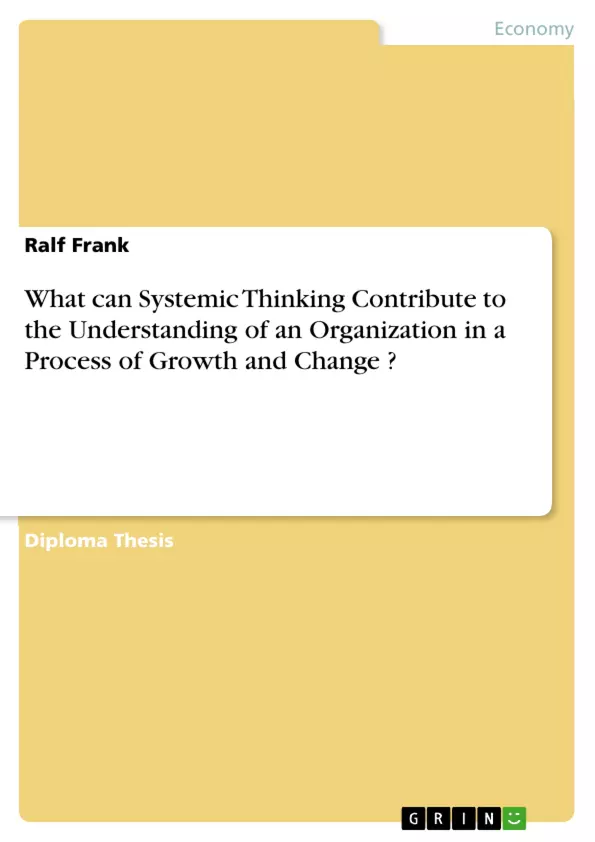INTRODUCTION
This chapter will take the reader to the starting point of this paper which is determined by the question as to which motivation led to choosing the topic of this MBA assignment and in which area of management studies the topic can be located. Furthermore, this chapter will seek to delineate the research area and try to describe which boundaries confine the subject.
Change management is a contemporary subject in management and business studies. There is a vast body of literature on the management of change encompassing numerous recipes and prescriptions on how to turn around organizations, how to induce change, and how to organize, streamline, re-engineer, re-structure organizations. Some of the material is written in an easy-to-read, easy-to-implement fashion. Some of the concepts in the light of academic scrutiny turn out to be business fads(3) . Others, on in-depth study are revealed to be paraphrased ideas from the 1920s and 1930s(4) . And even the more serious accounts of change and managerial intervention - the critique also finds ample evidence beyond 'airport literature'(5) - sometimes are based on over-simplified accounts which retrospectively explain implementing a nouvelle management practice as a veni, vidi, vici: rational, well-planned, coherent managerial action(6) . Finally, to take issue with the distribution of business success recipes, management recipes are often disseminated into the business community through business consultants, "merchants of meaning and beautiful words"(7) . Within the business community there is ample suspicion that consultants arbitrarily come up with new cures to well-known evils every other year - and nothing ever changes.
[...]
_____
3 Pascale (1990:18pp)
4 See e.g. Mumford (1996:46pp) on Mary Parker Follett's ideas.
5 I am indebted to an unknown author for this phrase.
6 Marchington (1995:52pp)
7 Czarniawska-Joerges, quoted from: Björkegren (1994:101)
Inhaltsverzeichnis (Table of Contents)
- ACKNOWLEDGMENTS
- PREFACE
- SYNOPSIS
- INTRODUCTION
- THE NATURE OF SYSTEMS
- Systems as Networks
- Systems as Dynamic Processes
- Open and Closed Systems
- Systems Thinking
- SYSTEMIC THINKING AND ORGANIZATIONS
- Complexity and its Impact on Management
- The Importance of System Archetypes and Causal Loops
- Social Systems and the Concept of Self-Reference
- F.C.M. CORPORATION - A CASE STUDY
- F.C.M.'s Growth Strategy
- F.C.M.'s Problems and Challenges
- SYSTEMIC ANALYSIS OF F.C.M. CORPORATION
- The Growth Cycle
- Integration and Coordination
- Self-Referential Loops and Growth
- CONCLUSIONS
Zielsetzung und Themenschwerpunkte (Objectives and Key Themes)
This dissertation aims to explore the potential contribution of systemic thinking in understanding and addressing the challenges faced by organizations in a process of growth and change. The study examines the application of systemic theory and models to a real-world case study of F.C.M. Corporation, a global manufacturer and distributor of construction equipment.
- The nature of systems and systemic thinking
- The application of systemic thinking to organizations
- The challenges of growth and change in organizations
- The case study of F.C.M. Corporation and its growth strategy
- The role of systemic thinking in addressing F.C.M.'s problems and challenges
Zusammenfassung der Kapitel (Chapter Summaries)
- The dissertation begins by introducing the concept of systemic thinking and its key principles, including the importance of understanding systems as networks, dynamic processes, and self-referential entities. It then discusses the implications of systemic thinking for organizations, highlighting the challenges of complexity, the value of system archetypes and causal loops, and the dynamics of self-referential systems.
- The following chapter presents a case study of F.C.M. Corporation, a global manufacturer and distributor of construction equipment currently experiencing a period of growth and change. The chapter outlines F.C.M.'s growth strategy, which relies heavily on acquisitions, and the problems and challenges faced by the organization, such as low market share, low profitability, and integration issues.
- A systemic analysis of F.C.M. Corporation is then conducted, exploring the dynamics of the organization's growth cycle, its integration and coordination challenges, and the impact of self-referential loops on its growth processes.
Schlüsselwörter (Keywords)
This dissertation focuses on the application of systemic thinking to organizational growth and change, exploring concepts such as systems theory, system archetypes, causal loops, self-referential systems, complexity, integration, and coordination. The case study of F.C.M. Corporation provides a real-world example to illustrate these concepts and their practical application.
- Quote paper
- Ralf Frank (Author), 1998, What can Systemic Thinking Contribute to the Understanding of an Organization in a Process of Growth and Change ?, Munich, GRIN Verlag, https://www.grin.com/document/2382



